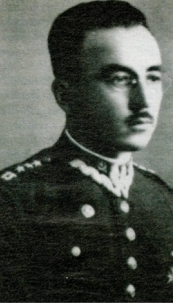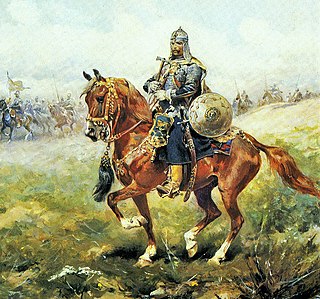 W
WThe Polish cavalry can trace its origins back to the days of medieval cavalry knights. Poland is mostly a country of flatlands and fields and mounted forces operate well in this environment. The knights and heavy cavalry gradually evolved into many different types of specialised mounted military formations, some of which heavily influenced western warfare and military science. This article details the evolution of Polish cavalry tactics, traditions and arms from the times of mounted knights and heavy winged hussars, through the times of light uhlans to mounted infantry equipped with ranged and mêlée weapons.
 W
WThe Battle of Schoenfeld took place on 1 March 1945 during World War II and was the scene of the last mounted charge in the history of the Polish cavalry and the last confirmed successful cavalry charge in world history. The Polish charge overran German defensive positions and forced a German retreat from the village of Schoenfeld (today known as Żeńsko, formerly known in Polish as Borujsko In March 1945, the First Army of the Polish People's Army was advancing into Pomerania as part of an overall push by Soviet forces to reach the Baltic Sea and the area of Stettin. Schoenfeld was part of the third line of fortifications built by the Germans to shelter Pomerania from attack.
 W
WThe charge at Krojanty, battle of Krojanty, the riding of Krojanty or skirmish of Krojanty was a cavalry charge that occurred during the invasion of Poland in the Second World War. It took place on the evening of 1 September 1939 near the Pomeranian village of Krojanty. Polish soldiers advanced east along the former Prussian Eastern Railway to railroad crossroads 7 kilometres from the town of Chojnice (Konitz) where elements of the Polish cavalry charged and dispersed a German infantry battalion. Machine gun fire from German armoured cars that appeared from a nearby forest forced the Poles to retreat. However, the attack successfully delayed the German advance, allowing the Polish 1st Rifle battalion and Czersk Operational Group to withdraw safely.
 W
WChorągiew was the basic administrative unit of the Polish and Lithuanian cavalry from the 14th century. An alternative name until the 17th century was Rota.
 W
WCzapka is a Polish and Belarusian generic word for a cap. However, it is perhaps best known to English speakers as a word for the 19th-century Polish cavalry headgear, consisting of a high, four-pointed cap with regimental insignia on the front to which feathers or rosettes were sometimes added.
 W
WThe Polish hussars, or Winged hussars, were one of the main types of Polish cavalry in Poland and in the Polish–Lithuanian Commonwealth between the 16th and 18th centuries.
 W
WAleksander Jeljaszewicz, known as "Sasza". was a Major in the Polish Army. He was the commander of the last Tatar/Islamic unit in the Polish military.
 W
WA lancer was a type of cavalryman who fought with a lance. Lances were used in mounted warfare by the Assyrians as early as 700 BC and subsequently by Greek, Persian, Gallic, Chinese, and Roman horsemen. The weapon was widely used in Asia and Europe during the Middle Ages and the Renaissance by armoured cavalry, before being adopted by light cavalry in Europe and Central Asia. In a modern context, a lancer regiment usually denotes an armoured unit.
 W
WLisowczycy – the name of an early 17th-century irregular unit of the Polish-Lithuanian light cavalry. The Lisowczycy took part in many battles across Europe and the historical accounts of the period characterized them as extremely agile, warlike, and bloodthirsty. Their numbers varied with time, from a few hundreds to several thousands.
 W
WThe Battle of Mokra took place on September 1, 1939 near the village of Mokra, 5 km north from Kłobuck, 23 km north-west from Częstochowa, Poland. It was one of the first battles of the Invasion of Poland, of the Second World War and one of the few Polish victories of that campaign, as well as the first German defeat of the conflict.
 W
WThe National cavalry was a branch of Polish–Lithuanian cavalry in the Polish-Lithuanian armed forces in the last quarter of the 18th century. Formed as a merger of previously-existing units of Winged hussars, pancerni and petyhorcy that were still in service after the Confederation of Bar. In 1777 the Sejm new regulations converted all units of heavy cavalry and medium cavalry and reformed them into a line cavalry, roughly similar to later uhlans popular in Europe in the 19th century. Existing dragoon and Front or Vanguard Regiments were outside this reform The National Cavalry had a very short history of 20 years, and some units stationed in the eastern Polish–Lithuanian Commonwealth were forcibly incorporated into the Russian cavalry following the Second Partition of Poland, and the remainder was disbanded together with the rest of Polish–Lithuanian armed forces after the final partition in 1795. The Sejm's 1777 decision was a rather late effort to modernize Polish–Lithuanian cavalry, along with the much earlier trend of evolution of European cavalry towards the more modern organization of the cavalry regiments into more mobile formations. The most modern part of the reform was the establishment of some very modern battle dress uniforms for these cavalrymen, and in turn, this uniform of the National Cavalry inspired numerous similar uniforms and employment of 'Polish lance' in the rest of Europe, notably the Austrian, Prussian, Russian cavalry, and later of the French cavalry of the Napoleonic Wars.
 W
WThe Polish Cavalry Monument, also known as the Millennium Polish Cavalry Monument, is a statue located at the Polish Cavalry Roundabout in Warsaw.
 W
WThe Polish hussars, or Winged hussars, were one of the main types of Polish cavalry in Poland and in the Polish–Lithuanian Commonwealth between the 16th and 18th centuries.
 W
WA Towarzysz was a junior cavalry officer or knight-officer in the army of the Polish–Lithuanian Commonwealth from the 16th century until the Commonwealth's demise in 1794.
 W
WA Towarzysz pancerny was a medium-cavalryman in 16th to 18th century Poland, named after their chainmail armor ("pancerz"). These units were the second-most-important cavalry in the Polish-Lithuanian army, after the hussars.
 W
WUhlans were Polish-Lithuanian light cavalry units armed with lances, sabres and pistols. The Polish uhlans became the model for many general-purpose cavalry units throughout Europe in the early 19th century as use of traditional heavy cavalry declined. The title was later used by lancer regiments in French, Russian, Prussian, Saxon, Austrian and other armies.